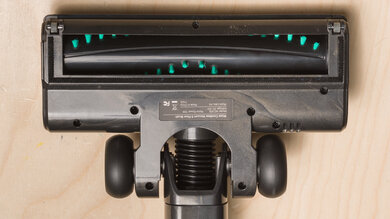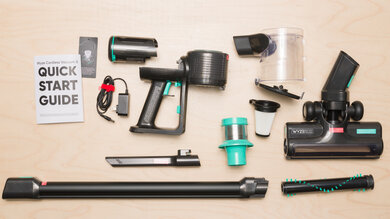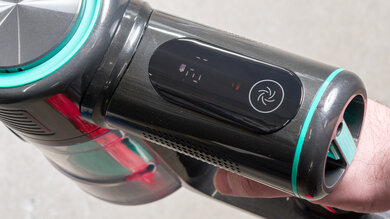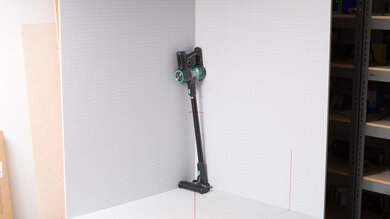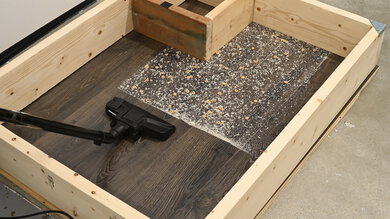
Tile floors can be a surprisingly tricky surface for vacuums to clean. Debris gets trapped in the various crevices between tiles, so a vacuum with sufficient suction power is a must. Of course, performance isn't the only factor to consider. Attachments for cleaning shelves and countertops can also be helpful, while a design that's easy to maintain and incurs low recurring costs is also important. You might also want to consider a vacuum with a mopping capability for dealing with liquid spills or dried-on stains in kitchens.
We've tested over 100 vacuum cleaners, and below are our recommendations for the best vacuums for tile floors. These picks are selected based on their performance on bare floors and their feature set, design, and price. For more options, look at our list of the best vacuums, the best hardwood vacuums, and the best multi-surface vacuums. Or, if you want to offload some of your day-to-day cleaning, consider a robot vacuum! We've updated our robot vacuum testing methodology to better represent real-world use. Check out our recommendations for the best robot vacuums.
If you've noticed a buildup of humidity in your bathroom or basement, you'll be happy to know we now test dehumidifiers. You can take a look at our recommendations for the best dehumidifiers and the best dehumidifiers for basements.
-
Best Vacuum Cleaner For Tile Floors
Bare Floor7.8Vacuum TypeStick/HandheldBaglessYesCordlessYesAnti-Allergy Filter (HEPA)YesWet CompatibleNoThe best vacuum for tile floors we've tested is the Dyson V15 Detect. This stick vacuum has an extra floorhead with a fluffy brushroll for cleaning bare surfaces and a built-in laser light that illuminates finer material. It performs remarkably well on bare surfaces like tile floors and does an excellent job of clearing away debris in shallow crevices. One of its headlining features is its particle detection system, which can help give you a rough idea of allergen quantities within your home. Its battery performance is strong overall, as you can expect a max of over an hour of runtime on a single charge, though that does drop dramatically when you use the vacuum in its more powerful suction mode.
The Dyson V12 Detect Slim is worth a look if you want a smaller, lighter alternative. However, its dirt compartment is notably smaller, and its less potent suction motor means it isn't as effective in dealing with debris in cracks and crevices. Alternatively, if you'd prefer a corded vacuum for longer cleaning sessions, the Miele Complete C3 is an extremely well-rounded machine. However, its canister form factor makes it slower to set up than the Dyson vacuum, and its power cord is on the shorter end of the scale.
-
Best Upper Mid-Range Vacuum For Tile Floors
Bare Floor7.7Vacuum TypeStick/HandheldBaglessYesCordlessYesAnti-Allergy Filter (HEPA)YesWet CompatibleNoConsider the Shark Stratos Cordless if you're shopping at an upper mid-range price bracket. This vacuum is bulkier than the Dyson V15 Detect and has a slightly shorter battery life of about 60 minutes, which is still pretty good. Besides, the Shark has plenty to offer. It delivers similarly fantastic debris pickup on bare floors, and like the V15, it's also capable of automatically adjusting its suction power. However, the Shark's system works by matching suction power to the amount of debris being sucked up rather than adapting to changes in surface type.
While it's heavier than the Dyson and has a bulkier twin-roller floorhead, its bendable wand makes cleaning under tables and chairs much easier since you won't have to stoop too much. This vacuum also features a somewhat unique odor neutralization system, which works through a replaceable cartridge in its floorhead that emits a detergent-like scent as you clean.
-
Best Mid-Range Vacuum For Tile Floors
Bare Floor7.5Vacuum TypeStick/HandheldBaglessYesCordlessYesAnti-Allergy Filter (HEPA)YesWet CompatibleNoIf you're shopping at a mid-range price point, the Tineco PURE ONE S11 is a great choice. Now, there are a few obvious downsides compared to the pricier Shark Stratos Cordless: it's not as well-built, has a shorter max runtime of about 40 minutes, and has a smaller dirt compartment, so it's not as well-suited for the longest cleaning sessions. However, it's still very well-equipped for a vacuum in this price bracket. Like the Shark, it can automatically adjust its suction power setting depending on the amount of debris it detects. It also has a HEPA filter that's fairly effective in sealing in allergens as you clean, but like any bagless vacuum, you need to be careful when emptying its dustbin, which can release a cloud of fine grit and dust.
If you'd prefer to go corded when searching for a vacuum to clean tile floors, the Pure Suction variant of the Miele Classic C1 is a good choice. Being a bagged canister vacuum, it isn't a like-for-like alternative. However, it's worth a look if you're willing to sacrifice the ease of deployment and go-anywhere range of a cordless vacuum for the all-out cleaning performance and unlimited runtime of an intermediate corded vacuum. It's also much better built than the Tineco, and its bagged design makes it easier to maintain.
-
Best Lower Mid-Range Vacuum For Tile Floors
Bare Floor6.9Vacuum TypeStick/HandheldBaglessYesCordlessYesAnti-Allergy Filter (HEPA)YesWet CompatibleNoThe Wyze Cordless Vacuum S is the best cordless vacuum for tile floors at a lower mid-range price point we've tested. Unlike the Tineco PURE ONE S11, it can't automatically adjust its suction power on the fly. It also lacks a fluffy brushroll that could help clear finer debris from cracks and crevices, but its multi-surface head is reasonably effective when it comes to cleaning bare surfaces like tile. There's also a crevice tool included to help you reach tighter spots. It's equipped with a HEPA filter, which is rare at this price point and helps with sealing in allergens, although emptying its dustbin can release a cloud of dirt if you aren't careful. Its maximum battery life of around one hour is similar to the Tineco's, but of course, it drops dramatically when using its maximum power setting.
This model replaces our previous recommendation for the Wyze Cordless Vacuum, which has been discontinued and is increasingly difficult to find available. However, if you can get your hands on it or you're wondering if you should update yours, note that the first edition performs a little better overall and also comes with a 2-in-1 brush and wall mount. The maximum battery life is a little longer with the S model, however.
-
Best Budget Vacuum For Tile Floors
Bare Floor7.3Vacuum TypeCanisterBaglessNoCordlessNoAnti-Allergy Filter (HEPA)NoWet CompatibleNoThe best budget vacuum for tile floors we've tested is the Eureka Mighty Mite. This compact canister vacuum isn't as powerful or well-built as a higher-end model like the Miele Classic C1. It also lacks the grab-and-go convenience of a cordless model like the Wyze Cordless Vacuum S. That said, it's very affordable and does a fantastic job of sucking up pet hair and solid debris on bare surfaces like tile floors. Its floorhead has bristles you can retract, which helps with cleaning any low or medium-pile area rugs. Its overall design is very simple to maintain, and you can easily access and replace its filters and dust bag.
The vacuum's compact size lets you easily maneuver it in tight spaces, and it's light enough to pick up and carry without a ton of effort. However, the power cord and hose aren't long, so you'll probably need to swap outlets when cleaning larger areas. It's also worth noting that some newer variants of this vacuum lack the requisite mounting points to install an aftermarket post-motor exhaust filter.
-
Best Hybrid Vacuum For Tile Floors
Bare Floor6.6Vacuum TypeUprightBaglessYesCordlessYesAnti-Allergy Filter (HEPA)NoWet CompatibleCompatible without immersionIf you're looking for a vacuum that can pull double-duty as a mop for handling kitchen spills, the BISSELL CrossWave Cordless Max is a great choice. Unlike our other recommendations, it can suck up liquids and has a detergent dispersal feature, which sprays cleaning solution onto its brushroll to tackle dried-on stains on hard floors. While its suction force is weaker than conventional higher-end vacuums, it still does a good job of sucking up solid debris on bare floors. It's also capable of dealing with material in shallow cracks and crevices. It feels decently well-built and has a fairly large dirt compartment, so you won't need to empty it too frequently.
However, it lacks an allergen-trapping HEPA filter, and some fine particles can escape through its post-motor exhaust, so it isn't the best option if you suffer from allergies. Its battery life of about 40 minutes is solid, but if you are looking for even longer, you could always consider the BISSELL CrossWave Pet Pro. Its corded design makes it a better option for longer cleaning sessions, though you lose the go-anywhere range of the Max.
Notable Mentions
- Miele Duoflex HX1:
For a significantly sturdier cordless vacuum that still offers great performance, consider the Miele Duoflex HX1 rather than the Dyson V15 Detect. The Dyson still performs better overall, but the Miele is feature rich and feels premium and rigid with the use of high quality plastic and a metal wand.
See our review - Dyson Gen5detect/Gen5detect Absolute: The Dyson Gen5detect/Gen5detect Absolute replaces the Dyson V15 Detect as the brand's flagship cordless stick vacuum. Aside from minor updates like a revamped control scheme and brighter LED light for its fluffy-roller floorhead, it isn't all that different from its predecessor, and you're better off saving your money on the much cheaper V15, which delivers all but identical performance. See our review
- Dyson Gen5outsize/Gen5outsize Absolute: The Dyson Gen5outsize/Gen5outsize Absolute is mechanically related to the Gen5detect/Gen5detect Absolute but features an enlarged dustbin and wider floorhead. It delivers a similarly fantastic performance, but it doesn't do enough to justify the price hike over the Dyson V15 Detect, and its bulkier design makes it unwieldy to maneuver in tight spots. See our review
- Dyson V15s Detect Submarine: The Dyson V15s Detect Submarine is essentially a reprogrammed variant of the Dyson V15 Detect that you can use with a specially designed additional floorhead meant for wetting and scrubbing away stains on hard floors. However, with this attachment in place, it's incapable of mopping away stains and dealing with solid debris at the same time. See our review
- Samsung Jet 90 Complete: The Samsung Jet 90 Complete is an upper mid-range cordless stick vacuum. It delivers more power than the Shark Stratos Cordless and is compatible with a unique scrubbing attachment for dealing with stains on hard floors. However, it lacks an automatic power adjustment feature and is currently difficult to find. See our review
Recent Updates
-
We added information about the Wyze Cordless Vacuum S, which we have now tested and is a good alternative to the Wyze Cordless Vacuum as the 'Best Lower Mid-Range Vacuum For Tile Floors.' Otherwise, our recommendations haven't changed.
-
We've swapped out the Miele Triflex HX1 and Miele Triflex HX2 Cat & Dog for the Miele Duoflex HX1 in the Notable Mentions, as it offers better build quality and performance. We've also removed the Shark Cordless Pro from the Notable Mentions as it offers no advantage over the Shark Stratos Cordless. Finally, edits for clarity have been made throughout.
-
Sep 24, 2024 : We've verified our recommendations, ensuring they represent the best choices, and made small edits for clarity.
-
Mar 15, 2024 : Added the Miele Triflex HX2 and Dyson V15s Detect Submarine to the Notable Mentions. Removed less relevant Notable Mentions picks.
-
Jan 16, 2024 : Added Dyson Gen5outsize/Gen5outsize Absolute to Notable Mentions.
All Reviews
Our recommendations are based on what we think are currently the best vacuum cleaners for tile floors. We don't just base our results on overall performance but also on factors like availability, price, and reader feedback.
If you would like to do the work of choosing yourself, here is the list of all our vacuum reviews, ranked by bare floor performance. Be careful not to get too caught up in the details. While there's no single best vacuum, most are good enough to please almost everyone, and the differences are often not noticeable unless you really look for them.
Comments
Best Vacuum For Tile Floors: Main Discussion
What do you think of our picks? Let us know below.
Looking for a personalized buying recommendation from the RTINGS.com experts? Insiders have direct access to buying advice on our insider forum.
We’ve just released a new video that mentions the Samsung Jet 90 Complete here.




















